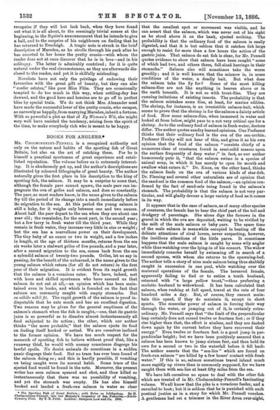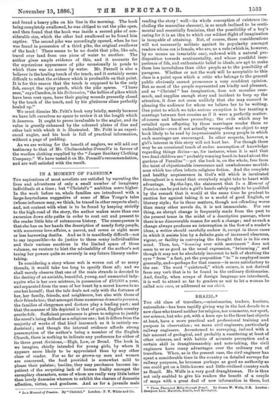BOOKS FOR ANGLERS.*
Mn. CHOLMONDELET-PENNELL is a recognised authority not only on the nature and habits of the sporting fish of Great Britain, but also on the art of catching them. For he is himself a practical sportsman of great experience and estab- lished reputation. The volume before us is extremely interest- ing. It is ahndsornely got up, and the author's descriptions are illustrated by coloured lithographs of great beauty. The author naturally gives the first place in his description to the king of sporting fish, the salmon. It may be a surprise to some that, although the female parr cannot spawn, the male parr can im- pregnate the ova of grilse and salmon, and does so constantly. The parr, as most readers know, is the name given to the salmon fry till the period of its change into a smolt immediately before its migration to the sea. At this period the young salmon is still a baby, for it weighs only between one and two ounces. About half the parr depart to the sea when they are about one year old ; the remainder, for the most part, in the second year ; but a few tarry in fresh water till the third year. While they remain in fresh water, they increase very little in size or weight ; but the sea has a marvellous power on their development The tiny baby of an ounce or two in weight, and a few inches in length, at the age of thirteen months, returns from the sea six weeks later a stalwart grilse of five pounds, and a year later, after a second migration to the sea, comes back from the sea a splendid salmon of twenty-two pounds. Grilse, let us say in passing, for the benefit of the unlearned, is the name given to the young salmon which return (for all do not return) in the first year of their migration. It is evident from its rapid growth that the salmon is a voracious eater. We have, indeed, met with keen and skilled sportsmen who have assured us that salmon do not eat at all,—an opinion which has been main- tained even in books, and which is founded on the fact that salmon are commonly caught with empty stomachs. But ex nihilo nihil fit. The rapid growth of the salmon is proof in- disputable that he eats much and has an excellent digestion. Two reasons may be given for the general emptiness of the salmon's stomach when the fish is caught, —one, that its gastric juice is so powerful as to dissolve almost instantaneously all food subjected to its action ; the other, which our author thinks "the more probable," that the salmon ejects its food on finding itself hooked or netted. We are ourselves inclined to the former opinion. We have too much respect for the monarch of sporting fish to believe without proof that, like a runaway thief, he would with uneasy conscience disgorge his lawful spoils. No doubt animals do sometimes in a sudden panic disgorge their food. But no trace has ever been found of the salmon doing so ; and this is hardly possible, if vomiting on being caught were its normal habit. Some trace of the ejected food would be found in the nets. Moreover, the present writer has seen salmon speared and shot, and thus killed so instantaneously that there was no possibility of vomiting, and yet the stomach was empty. He has also himself hooked and landed a fresh-run salmon in water so clear
• The Sporting Fish of Great Britain; with Notes on Ichthyology. By H. Cholmondeley-Pennell, late her Majesty's Inspector of Bea Fisheries.—lforth, Country Flies. By T. E. Pritt. London: Sampson Low and 0o. ISM.
that the smallest spot or movement was visible, and he can assert that the salmon, which was never out of his sight as he stood above it on the bank, ejected nothing. The probability is that the ordinary food of the salmon is easily digested, and that it is but seldom that it catches fish large enough to resist for more than a few hours the action of the gastric juice. That salmon do eat fish is clear, for Mr. Pennell quotes evidence to show that salmon have been caught "some of which had two, and others three, full-sized herrings in their stomachs." Salmon also will sometimes take the worm greedily ; and it is well known that the minnow is, in some conditions of the water, a deadly bait. But what does the salmon take the fly for? Some of the most killing salmon-flies are not like anything in heaven above or in the earth beneath. It is not so with trout-flies. They are cunning imitations of existing insects. The probability is that the salmon mistakes some flies, at least, for marine edibles. The shrimp, for instance, is an irresistible salmon-bait, which seems to prove that the shrimp is for the salmon a dainty article of food. Now some salmon-flies, when immersed in water and looked at from below, might pass to a not very critical eye for a shrimp. As to the ordinary food of salmon in fresh water, doctors differ. The author quotes sundry learned opinions. One Professor thinks that their ordinary food is the ova of the sea-urchin. Professor Huxley will not hear of this, and gives it as his own opinion that the food of the salmon "consists chiefly of a numerous class of crustacea found in semi-solid masses upon the surface frequently of deep water ;" in fact, as our author humorously puts it, "that the salmon swims in a species of animal soup, in which it has merely to open its mouth and swallow what enters it." Dr. Knox, on the other hand, thinks the salmon feeds on the ova of various kinds of star-fish. Dr. Fleming and several other naturalists are of opinion that the sand-eel is the common food of the salmon,—an opinion con- firmed by the fact of sand-eels being found in the salmon's stomach. The probability is that the salmon is not very par- ticular, and will gladly devour a large variety of food as it comes in its way.
It appears that in the case of salmon, as of many other species of creatures, the female has to bear the chief part of the toil and drudgery of parentage. She alone digs the furrows in the gravel in which the ova are deposited, waiting to be vivified by the milt of the male salmon or baby parr. The spare time of the male salmon is meanwhile occupied in beating off the delicate attentions of rival lovers, never suspecting, however, the insidious attentions of the little parrs. It sometimes happens that the male salmon is caught by some wily angler while thus watching over the lying-in of his consort. The widow immediately consoles herself by swimming off in search of a second spouse, with whom she returns to the spawning-bed. The author tells a story of nine male salmon being thus shabbily caught in succession in one pool, while watching over the maternal operations of the female. The bereaved female, apparently failing to find or to entice a tenth husband, returned with "a large yellow trout,"—thus preferring a mulatto husband to widowhood. It has been calculated that salmon, when rushing at full speed, travel at the rate of four hundred miles a day. But, of course, they cannot main- tain this speed, if they do maintain it, except in short spurts. The muscular power of salmon in forcing their way through the water, or jumping out of it, is certainly extra- ordinary. Mr. Pennell says that "the limit of the perpendicular leap certainly does not exceed twelve or fourteen feet ; or if they rise higher than that, the effort is aimless, and they are dashed down again by the current before they have recovered their energy." Even twelve or fourteen feet is a good jump in per- pendicular height; but we have been positively assured that a salmon has been known to jump sixteen feet, and then hold its own for a second or two in the waterfall before it fell back. The author asserts that the " sea-lice " which are found on fresh-run salmon "are killed by a few hours' contact with fresh water." If this is so, salmon sometimes travel inland much more rapidly up rivers than is commonly supposed, for we have caught them with sea-lice at least fifty miles frbm the sea.
We have left ourselves no space to deal with the other fish which are treated of in Mr. Cholmondeley-Pennell's fascinating volume. We all know that the pike is a voracious feeder, and a cannibal to boot; but it is seldom that he is punished with such poetical justice as in a story for which Mr. Pennell vouches. A gentleman had set a trimmer in the River Avon over-night,
and found a heavy pike on his line in the morning. The hook being completely swallowed, he was obliged to cut the pike open, and then found that the hook was inside a second pike of con- siderable size, which the other had swallowed as he found him captive. The second pike was accordingly opened, when he too was found in possession of a third pike, the original swallower of the hook ! There seems to be no doubt that pike, like eels, travel over land from one piece of water to another. The author gives ample evidence of this, and it accounts for the mysterious appearance of pike occasionally in ponds to which there was no access by water. Mr. Pennell is also a believer in the healing touch of the tench, and it certainly seems difficult to rebut the evidence which is producible on that point. It is for this reason that the tench is supposed to be the only fish, except the spiny perch, which the pike spares. "I have seen," says Camden, in his Britannica, "the bellies of pikes which have been rent open, have their gaping wounds presently closed by the touch of the tench, and by his glutinous slime perfectly healed up."
We must dismiss Mr. Pritt's book very briefly, merely because we have left ourselves no space to review it at the length which it deserves. It ought to prove invaluable to the angler, and its value is greatly enhanced by the coloured plates of flies and other bait with which it is illustrated. Mr. Pritt is an experi- enced angler, and his book is full of practical information, without a page of padding.
As we are writing for the benefit of anglers, we will add our testimony to that of Mr. Cholmondeley-Pennell's in favour of the woollen clothing supplied by the "Jaeger Sanitary Clothing Company." We have tested it on Mr. Pennell's recommendation, and are well satisfied with the result.



































 Previous page
Previous page